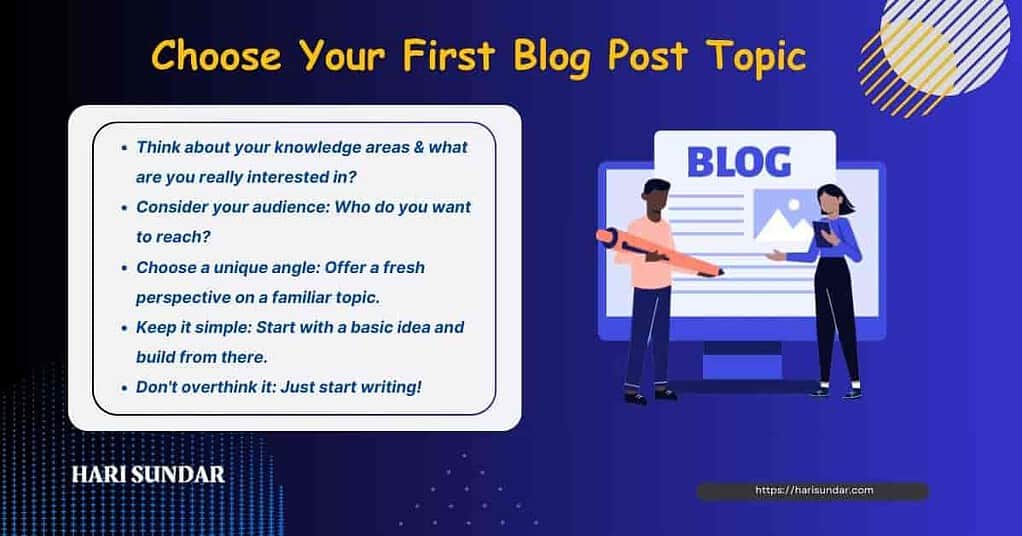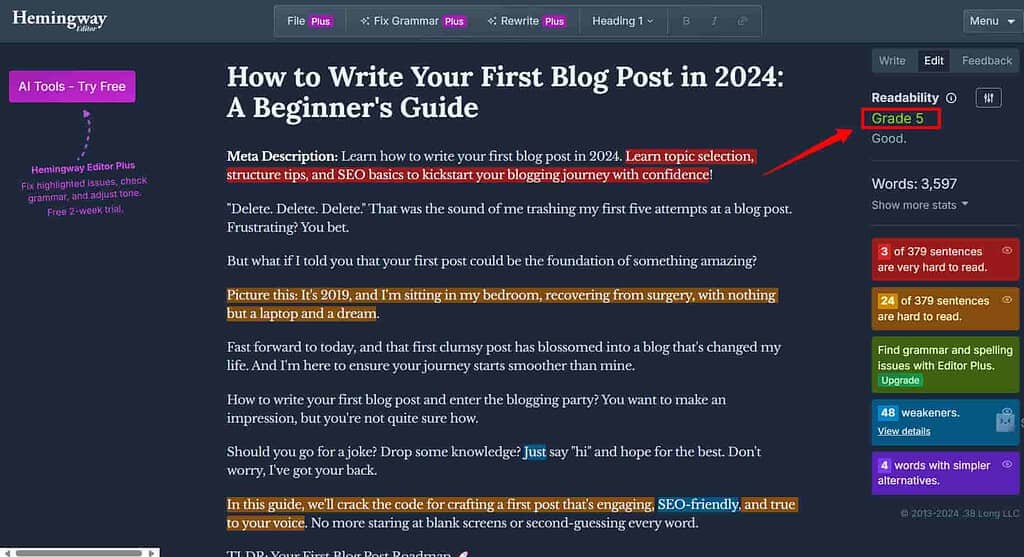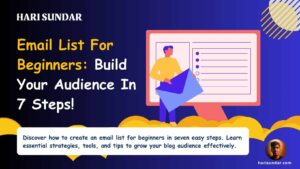How to Write Your First Blog Post in 2024: A Newbie’s Guide

“Delete. Delete. Delete.” That was the sound of me trashing my first five attempts at a blog post. Frustrating? You bet.
But what if I told you that your first post could be the foundation of something amazing?
Picture this: It’s 2019, and I’m sitting in my bedroom, recovering from surgery, with nothing but a laptop and a dream.
Fast forward to today, and that first clumsy post has blossomed into a blog that’s changed my life. And I’m here to ensure your journey starts smoother than mine.
How to write your first blog post and enter the blogging party? You want to make an impression, but you’re not quite sure how.
Should you go for a joke? Drop some knowledge? Just say “hi” and hope for the best. Don’t worry, I’ve got your back.
In this guide, we’ll crack the code for crafting a first post that’s engaging, SEO-friendly, and true to your voice. No more staring at blank screens or second-guessing every word.
Here’s what we are going to cover: Your First Blog Post Roadmap 🚀
- 🎯 Pick a topic you’re knowledgeable about
- 🧠 Brainstorm like a pro
- 📝 Craft a headline that hooks readers instantly
- 🗺️ Create an outline that keeps you on track
- ✍️ Write with authenticity (your unique voice matters)
- 🔍 Sprinkle in SEO strategies for visibility
- 📊 Format for easy reading and proofread your content
- 🚀 Hit publish and celebrate your new blogger status!
Ready to turn your ideas into a blog post that’ll make both you and your readers excited for more? Let’s dive in and get that first post out into the world!
1. Choose Your First Blog Post Topic

Starting your blogging journey is exciting, but that blank page can be daunting.
Newbie bloggers often struggle to come up with consistent content ideas. Don’t worry – I’ve been there too.
When I launched my first blog, I stared at my screen for hours, unsure where to begin. It was because of my perfectionism, that so avoided being a perfectionist.
Let’s break down how to choose that first topic.
Brainstorming is your key. Grab a notebook and jot down everything you’re interested in and knowledgeable about.
For me, it was a mix of digital marketing tips and personal growth stories. Don’t filter yourself – wild ideas often lead to unique content.
Try mind mapping or the “6-3-5” technique: write down 6 ideas in 3 minutes, then expand on 5 of them.
But passion alone isn’t enough. You need to know your audience. Who are you writing for? What problems can you solve for them?
When I shifted focus to addressing new bloggers’ pain points, I saw an increased engagement.
Use social media, forums, or even casual conversations to uncover what your potential readers are asking about.
Keyword research tools are game-changers for finding popular topics. I remember discovering Google’s Keyword Planner and feeling like I’d struck gold.
Tools like Ubersuggest or AnswerThePublic can reveal questions people are actually searching for.
Look for keywords with decent search volume but lower competition – perfect for new blogs. When you are starting, go for long-tail keywords as they are low competition and easy to rank for.
Here’s a pro tip: consider writing a “link bait” or a pillar post as your debut. These are highly shareable, valuable pieces that naturally attract backlinks.
My link bait post was a comprehensive guide on blog ideas for beginners. It took time to create, but the payoff in terms of traffic and credibility was huge.
Balancing your interests with reader demand is crucial. While you shouldn’t force yourself to write about topics you hate, finding overlap between your interests and what your audience wants is smart.
I love digital marketing, but I focus on beginner-friendly content because that’s what resonates with my readers.
Ready to nail down your first topic? Try this: list three of your interests, then brainstorm five potential post ideas for each. Research your audience and market value.
Which one makes you most excited to start writing?
Or, if you’re still unsure how to find your niche, check out my ultimate guide on how to find your niche. Now, let’s get into the next section.
2. Craft an Attention-Grabbing Title
Did you know that 8 out of 10 people will read your headline, but only 2 out of 10 will click through to the article? Your title is your first impression – let’s make it count.
A compelling blog post title hooks readers instantly. It should be clear, intriguing, and promise value.
My first blog post titles were vague and didn’t grab the reader’s attention.
“My Blogging Journey” became “5 Surprising Lessons From My First 30 Days of Blogging” – much more clickable!
For SEO, include your target keyword naturally.
If you’re writing about meal prep, “9 Easy Meal Prep Ideas for Busy Professionals” works better than just “Meal Prep Ideas.”
But don’t stuff your keywords – Google (and readers) will notice.
Power words or search intent trigger words are your secret weapon. Words like “essential,” “proven,” or “ultimate” can boost click-through rates.
This will strategically increase your traffic. Because there is a huge psychology behind using those trigger words.
Here are some effective title templates for beginners:
- How to [Achieve Desired Outcome] in [Timeframe]
- [Number] [Adjective] Ways to [Solve a Problem]
- The Ultimate Guide to [Topic] for Beginners
- Why [Common Belief] Is Wrong (And What to Do Instead)
Your title sets expectations. Can you craft one that makes readers think, “I can’t afford to miss this?”
3. Create a Solid Blog Post Outline
Want to cut your writing time in half? A study by the Content Marketing Institute found that bloggers who use outlines consistently produce content faster.
I learned this after wasting hours on my first few rambling posts. I learned to create outlines and a blogging checklist to publish posts faster.

Outlining before writing keeps you focused and organized. It’s like having a roadmap for your ideas. Start with your main points as H2 headers, then break those down into subpoints.
For example, if you’re writing about “5 Easy Dinner Recipes,” each recipe becomes an H2, with ingredients and steps as subpoints.
A basic blog structure includes an intro, main content (divided into sections), and conclusion. Don’t forget to leave space for your hook and call-to-action.
To organize your thoughts, try the “brain dump” method. Write down everything you know about your topic, then group similar ideas.
Tools like Trello can make this process a breeze. I use Google Docs to write blog posts and Notion for note-taking purposes.
For a quick start, grab a blog post outline template from sites like HubSpot or CoSchedule.
Your outline should be flexible. As you write, you discover new angles or better ways to present your ideas. The goal is to have a clear direction, not a rigid structure.
Ready to outline your first post? What’s the biggest challenge you think you’ll face in organizing your ideas? Drop it in the comments below, I love hearing your comments!
4. Write an Engaging Introduction
Did you know that you have about 8 seconds to grab a reader’s attention before they click away?
That’s why your introduction is crucial. When I started blogging, I’d run on paragraphs before getting to the point. Big mistake!
Start with a hook that captivates. This could be a surprising statistic, a thought-provoking question, or a bold statement.
For example, “What if I told you that 90% of bloggers are doing introductions wrong?” Instantly, your reader wants to know more.
Next, introduce your topic and why it matters. If you’re writing about time management hacks, you might say,
“In a world where money is unlimited but time is limited, mastering time management can be your ticket to success.” This tells the reader why they should care.
Set clear expectations. What will your reader learn? Be specific.
“In this post, you’ll discover 5 little-known time management techniques that helped me double my productivity in just a week.” Now your reader knows exactly what value they’ll get.
Transition smoothly into your main content. I like using the question:
“Ready to master your time? Let’s dive in with technique number one…” This creates a natural flow and keeps the reader engaged.
Your introduction is a promise to your reader. Make it compelling, clear, and concise. A good intro should make them think, “I need to read this entire post!”
Now, think about your favorite blog post. What was it about the introduction that kept you reading? How can you apply that to your writing?
5. Develop Your Main Content with Clarity
As I mentioned earlier, the average person’s attention span is now just 8 seconds. That’s less than a goldfish!
In the beginning stages of my blogging, I’d write long, winding paragraphs. My bounce rate was through the roof. Let’s fix that.
Break complex ideas into bite-sized chunks. Use subheadings to guide your reader. If you’re explaining SEO, don’t dump everything at once.
Start with “What is SEO?”, then move to “Why SEO Matters”, and so on.
Examples and analogies are your best friends. When I explain keyword research, I compare it to fishing.
Keywords are like fishes, you have to go where the fish are. That is, you have to go for keywords that your audience is searching for. It clicks instantly for most people.
Don’t just state facts – back them up. Articles with statistics are more likely to be shared. And make sure your sources are credible.
Keep your tone consistent. If you start casual and funny, don’t suddenly switch to formal and dry. I once made this mistake and got feedback that my post felt “schizophrenic”. Ouch.
Here’s the infographic of the blog post checklist that you can follow:

Clarity trumps cleverness. Your goal is to make your reader think, “Wow, I finally understand this!” How can you simplify your next complex topic?
6. Write a Strong, Effective Conclusion
You’ve taken your readers on a journey, and now it’s time to land the plane smoothly. A strong conclusion isn’t just a recap—it’s your last chance to make an impact.
Here’s how to nail it:
- Briefly summarize your main points: Refresh your readers’ memory, but don’t just copy-paste. Think of it as a greatest hits compilation.
- Reinforce your main message: What’s the one thing you want readers to remember? Make it crystal clear.
- End with a bang: Use a powerful quote, a thought-provoking question, or a call to action that motivates readers.
- Look ahead: Tease what’s coming next on your blog to keep readers hooked.
- Be authentic: Share a final personal insight or anecdote to connect with your audience.
When I wrote my first blog post conclusion, it felt like trying to end a phone call with a chatty friend. But with practice, I learned to wrap things up effectively without sounding abrupt.
Remember, your conclusion is the last impression you’ll make. Make it actionable!
7. Add a Strong Call-to-Action (CTA)
Without giving a clear next step for your readers, how can you expect them to take action? It’s like inviting guests to a party and forgetting to show them where the snacks are.
Let’s fix that with a strong call-to-action (CTA) that’ll keep your audience engaged long after they’ve finished reading.
In my first few posts, my CTAs were as awkward as a penguin at a disco. Then, I learned that effective CTAs can transform casual readers into loyal followers.
Here are the steps that make your CTAs pop:
- Choose your CTA flavor: For your first post, consider a “Subscribe to my newsletter” or “Check out my related post on [topic]” CTA. These are like offering a friendly handshake to your readers.
- Craft copy that sizzles: Instead of a boring “Subscribe now,” try “Join the [your blog name] family for weekly tips and laughs!” Make it sound like an invitation to an exclusive club.
- Smart placement is key: Stick your CTA where it makes sense – maybe after a particularly juicy tip or at the end of your post. But don’t go overboard; nobody likes a pushy salesperson.
- Keep score: Use your blog’s analytics to track which CTAs are hitting the mark. It’s like a game of darts – aim, throw, and adjust based on where you land.
Don’t forget that your CTA is your blog post’s grand finale. Make it to encourage readers to take action!
8. Implement SEO Best Practices
Around 75% of users never scroll past the first page of search results.
When I started blogging, I ignored to learn SEO and wondered why no one found my posts. Don’t ignore to learn SEO.

On-page SEO is your ticket to better visibility. It’s about optimizing your content so search engines understand what it’s about. Think of it as speaking Google’s language.
Your target keyword is crucial. Use it in your title, and first paragraph, first H2 header, and sprinkle it naturally throughout.
But don’t overdo it – keyword stuffing is so 2010. I aim for a keyword density of about 1-2%.
For example, if your post is about “homemade dog treats,” use variations like “DIY pet snacks” or “healthy canine cookies.”
Meta descriptions are your 160-character sales pitch in search results. Make them compelling! Include your keyword and a clear benefit for the reader.
If you’re a beginner, check out my guide on SEO for new bloggers. It will help you clearly understand the basics of SEO.
Don’t forget the image alt text. It helps visually impaired readers and tells Google what your images are about.
Describe the image accurately and include your keyword if relevant.
Linking is powerful. Internal links help search engines understand your site structure and keep readers engaged. External links to authoritative sources boost your credibility.
I try to include 1-2 internal links every 500 words and 1-2 external links per 1000 words.
Remember, SEO is a marathon, not a sprint. Focus on creating valuable content first, then optimize it.
What’s one SEO technique you’ll implement in your next post?
9. Master Basic Formatting for Readability
A shocking truth is that around 43% of people admit to skimming blog posts. But with the right formatting, you can capture even the skimmers.
Using proper headings structure will guide your readers. Use H1 as title, H2 for main sections, and H3 for subsections.
Think of it like chapters in a book. My rule of thumb is to use a new H2 every 300-400 words or so.
Paragraphs? Keep them short and sweet. Aim for 2-3 sentences max. It’s better and easier to read, and it is less intimidating on mobile screens.
Bullet points and numbered lists are gold. They:
- Break up text
- Highlight key information
- Are easy to skim
Looking at my old blog, you will notice a huge difference in how I have improved my blog posts over the years for better readability and user experience.
Don’t forget visuals. A relevant image or infographic can explain complex ideas in seconds. I always try to include at least one visual per 500 words.
Your post should look inviting at first glance. Imagine you’re a busy reader – would you want to dive into your content? If not, it’s time to break out those formatting tools.
What’s one formatting trick you can implement in your next post to boost readability?
10. Edit and Proofread Your First Draft
Want to know a secret? Even seasoned writers don’t nail it on the first try. When I finished my first draft, I thought it was good. Then I took a break, came back, and… yikes.
Step away from your draft for at least a few hours, ideally overnight. It’s like clearing your mental palette.
When you return, you’ll spot issues you missed before.
But don’t be like making every word perfect. If you’re a perfectionist you won’t publish the post until you make every word perfect.
Have a ‘good-enough, move-on‘ mindset because you can always update your post later.
Grammar, spelling, and punctuation errors can kill your credibility.
I once used “their” instead of “there” in a headline. Embarrassing! Tools like Grammarly can catch these mistakes, but don’t rely entirely on them.
For a final polish, try the Hemingway app. It highlights complex sentences and suggests simpler alternatives. My readability scores improved dramatically when I started using it.
Thanks to the Hemingway app, I can now publish posts with an 8th-grade reading level. I have even published posts below the 8th-grade level, and I love to explain complex things in a simpler format.
See the below screenshot, I edited this blog post using the Hemingway app. Look at the readability level.

Read your post aloud. It sounds silly, but checking for flow and coherence is the best way. If you stumble while reading, your audience will too.
I often find myself rearranging entire paragraphs after this exercise.
Editing your content not only fixes errors but also makes it shine. Cut the fluff, clarify your points, and make every word count.
Ready to tackle your draft? What’s your biggest editing challenge? Tell me in the comments below!
Now, are you ready to publish and promote your post? Let’s get into the next part.
11. Publish and Promote Your First Blog Post
You’ve written your masterpiece, but hitting “publish” is just half of the work. Let’s make sure your hard work doesn’t get lost in the internet void.
Before getting your post online, run through this quick checklist:
- Proofread one last time (trust me, typos love to hide)
- Check all your links work
- Make sure your images load properly
- Preview your post to catch any formatting hiccups
Now, when should you hit that publish button? Find what time your audience is most active. Experiment and see what sticks.
Once it’s live, shout it from the digital rooftops:

- Share on social media, but tailor your message for each platform
- Send an email to your subscribers (even if it’s just your mom at this point)
- Reach out to other bloggers or communities in your niche
Don’t forget to keep the conversation going. Respond to comments like you’re chatting with friends at a coffee shop.
Answer their questions and ask them questions, share extra insights, and be genuinely interested in what your readers have to say.
When I published my first post, I was so nervous I nearly forgot to share it anywhere. Don’t make my mistake – your words deserve to be read!
Now let’s get into the conclusion part and promise yourself that after reading this, you should publish your first post.
Conclusion
You’ve got this! Your first blog post is within reach, and trust me, it’s going to feel amazing when you hit publish.
Every blogging superstar you admire started exactly where you are right now.
Here’s your action plan:
- Choose your topic
- Craft that attention-grabbing title
- Outline your main points
- Write, edit, and format for readability
- Sprinkle in some SEO magic
- Proofread like your reputation depends on it (because it does!)
- Add a strong, actionable CTA
- Take a deep breath and hit publish
Now, I want you to do something for me. In the next 48 hours, I challenge you to write and publish your very first blog post.
No excuses, no perfectionism – just do it!
You just need 1-2 hours a day to write your blog post. Or you can do it in one go, it will take you around 3 hours to write.
Then, come back here and share how you have written your first blog post in the comments. I can’t wait to read what you create and celebrate this milestone with you. Your blogging journey starts now!
FAQs On How To Write Your First Blog Post
How long should my first blog post be?
Aim for 1000-1500 words. It’s long enough to provide value but not overwhelming. Quality trumps quantity, though. Focus on delivering useful information rather than hitting a specific word count.
Do I need to be an expert to write my first post?
Not at all! Write about what you know and are knowledgeable about. And, make sure it has a market value.
Your unique perspective is valuable. As you blog more, you’ll naturally become more knowledgeable. Start with what you have and grow from there.
What if no one reads my first blog post?
Don’t sweat it! Most first posts don’t go viral. It’s about starting your journey. Share it on social media, tell friends, and keep writing. Consistency is key. Your audience will grow over time.
How do I come up with a good blog post idea?
Think about questions you’ve had or problems you’ve solved. What do people often ask you about? Use keyword research tools to find popular topics in your niche. Combine your interests with audience demand.
Should I use AI to write my first blog post?
AI can be a helpful tool but I don’t rely on it entirely. Use it for ideas or outlines, but add your personal touch. Readers connect with authentic voices. Your experiences and opinions make your content unique.
Is it okay to include personal stories in my first post?
Absolutely! Personal stories make your content relatable and engaging. They show your human side and build trust with readers. Just ensure they’re relevant to your topic and add value.
How much editing should I do before publishing?
Edit thoroughly, but don’t obsess. Check for clarity, flow, and basic errors. Read it aloud to catch awkward phrasing. Consider having a friend review it. Remember, done is better than perfect.






